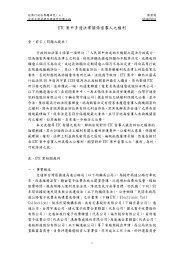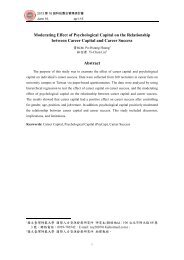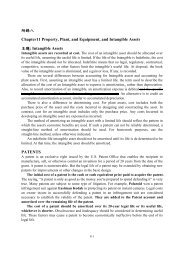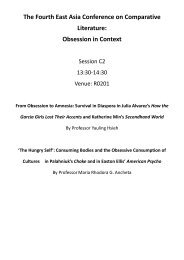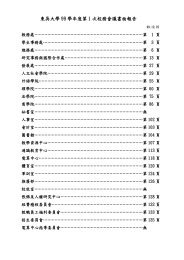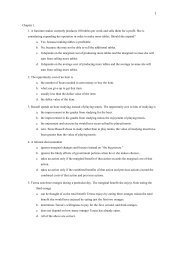The Power of the Pill: Oral Contraceptives and Women's ... - Mail
The Power of the Pill: Oral Contraceptives and Women's ... - Mail
The Power of the Pill: Oral Contraceptives and Women's ... - Mail
You also want an ePaper? Increase the reach of your titles
YUMPU automatically turns print PDFs into web optimized ePapers that Google loves.
power <strong>of</strong> <strong>the</strong> pill 741<br />
State<br />
1969<br />
(1)<br />
Age <strong>of</strong> Majority<br />
1971<br />
(2)<br />
TABLE 2<br />
(Continued)<br />
1974<br />
(3)<br />
Earliest Legal Age to Obtain<br />
Contraceptive Services without<br />
Parental Consent<br />
1969<br />
(4)<br />
1971<br />
(5)<br />
1974<br />
(6)<br />
Wisc. 21 18 18 21 18 18<br />
Wyo. 21 21 19 21 21 14 or 19*<br />
Summary States<br />
!20: 7<br />
States<br />
!20: 18<br />
States<br />
!20: 43<br />
States<br />
≤16: 3<br />
States<br />
≤16: 12<br />
States<br />
≤16: 27 ‡<br />
Source.—1969: Pilpel <strong>and</strong> Wechsler (1969). 1971: U.S. Department <strong>of</strong> Health, Education, <strong>and</strong> Welfare (1974). 1974:<br />
Paul et al. (1974). <strong>The</strong> coding <strong>of</strong> <strong>the</strong> laws is as <strong>of</strong> June 1974. 1974: U.S. Department <strong>of</strong> Health, Education, <strong>and</strong> Welfare<br />
(1978).<br />
Note.—“Obtaining contraceptive services” means <strong>the</strong> ability to get <strong>the</strong> birth control pill. Some states had a different<br />
age for voluntary sterilization, <strong>and</strong> abortion laws occasionally differed as well. We use an age <strong>of</strong> 14 when <strong>the</strong> law was<br />
interpreted to mean that any minor could receive contraceptive devices without parental consent. Ala.: Law allows high<br />
school graduates <strong>and</strong> married women to obtain contraception, but not any female under <strong>the</strong> age <strong>of</strong> majority; <strong>the</strong>refore,<br />
an age <strong>of</strong> 17 is coded. Ark.: Age <strong>of</strong> majority is 18, but recent law allows all women to get state family planning services<br />
except single women at college away from home, who should go to a private doctor. Conn.: Age <strong>of</strong> majority was reduced<br />
to 18 in 1972. An earlier law enabled any minor <strong>of</strong> 18 or older to obtain health services. Kans.: Legislation in 1966<br />
allowed a physician to prescribe birth control to any woman at a public clinic, but <strong>the</strong> law was not universal. See,<br />
however, <strong>the</strong> discussion in Bailey (1997), which discusses <strong>the</strong> case <strong>of</strong> Lawrence, Kans. Ky.: A “mature minor” decision<br />
was effective in 1972. Maine: Physician must find “probable health hazard”; thus <strong>the</strong> law is not universal. Md.: Age <strong>of</strong><br />
majority is 21, but consent rights are given to those 18 years <strong>and</strong> older for contraceptive services. Mich.: Age <strong>of</strong> majority<br />
is lowered to 18 in 1972. Minn.: Law states that minors living apart from <strong>the</strong>ir parents can give consent to health services;<br />
thus <strong>the</strong> age in 1971 is given as 18 since it does not provide blanket coverage for 14–17-year-olds. N.J.: Age <strong>of</strong> majority<br />
is lowered to 18 in 1973. N.Y.: Pharmacists may sell contraceptives to minors 16 <strong>and</strong> older. <strong>The</strong> law was ambiguous with<br />
regard to physicians <strong>and</strong> parental consent. Ohio: Ohio has a mature minor doctrine established in 1956, but its relevance<br />
to birth control is unclear in 1971. Pa.: Minors 18 years <strong>and</strong> older (or high school graduates) may consent to any<br />
medical care. Va.: Age <strong>of</strong> majority is lowered to 18, <strong>and</strong> any individual under age 18 may consent to birth control<br />
services, except abortion <strong>and</strong> sterilization, effective July 1972. Wisc.: <strong>The</strong> restriction on contraceptives to unmarried<br />
individuals was put in question after <strong>the</strong> Eisenstadt v. Baird (1972) decision regarding a similar Massachusetts law.<br />
* <strong>The</strong> state has a comprehensive family planning program that does not exclude <strong>the</strong> provision <strong>of</strong> contraceptive<br />
services to minors, but <strong>the</strong>re is ei<strong>the</strong>r no mature minor doctrine in <strong>the</strong> state or no clear decision by <strong>the</strong> state attorney<br />
general concerning <strong>the</strong> legality <strong>of</strong> such a provision.<br />
†<br />
Age <strong>of</strong> majority is 18 for females <strong>and</strong> 21 for males.<br />
‡<br />
Seven states are ambiguous cases.<br />
extensions <strong>of</strong> <strong>the</strong> mature minor doctrine. Of <strong>the</strong> 21 states that changed<br />
<strong>the</strong>ir regulations between 1969 <strong>and</strong> 1971, 10 reduced <strong>the</strong> age <strong>of</strong> majority,<br />
10 instituted a mature minor doctrine, <strong>and</strong> one instituted a family planning<br />
act. 22<br />
Some ambiguity surrounds <strong>the</strong> meaning <strong>of</strong> <strong>the</strong>se legal changes. In<br />
no state was it per se illegal in 1972, for example, to prescribe or sell<br />
contraceptives to a minor. 23 Ra<strong>the</strong>r, <strong>the</strong> legality both before <strong>and</strong> after<br />
22<br />
<strong>The</strong> 1967 amendment to Title IV <strong>of</strong> <strong>the</strong> Social Security Act (Aid to Families with<br />
Dependent Children) requires state <strong>and</strong> local welfare agencies to provide contraceptive<br />
services to eligible individuals without regard to marital status <strong>and</strong> age. But this law would<br />
not have affected <strong>the</strong> ineligible population, <strong>and</strong> it is unclear how it affected teenagers in<br />
states without a mature minor doctrine.<br />
23<br />
Until 1966 it was illegal in Massachusetts to sell contraceptives. <strong>The</strong> law was modified<br />
after Griswold v. Connecticut (1965). From 1966 to 1972, it was illegal to sell contraceptives<br />
to unmarried persons, <strong>and</strong> sale to married persons required a prescription. That law was<br />
struck down by <strong>the</strong> U.S. Supreme Court in Eisenstadt v. Baird (March 1972). A similar<br />
Wisconsin law was overturned in Baird v. Lynch (1974, Civ. No. 71-C-254, W.D. Wis.). See<br />
U.S. Department <strong>of</strong> Health, Education, <strong>and</strong> Welfare (1974, 1978). <strong>The</strong>re is no evidence<br />
that <strong>the</strong>se laws were rigorously enforced.




